RationaI Design of CoIIoidaI Core/SheII Quantum Dots for OptoeIectronic AppIications
Xiang-Long Huang | Xin Tong | Zhiming M.Wang
Abstract—Colloidal core/shell quantum dots (QDs) are promising for solar technologies because of their excellent optoelectronic properties including tunable light absorption/emission spectra,high photoluminescence quantum yield(PLQY),suppressed Auger recombination,efficient charge separation/transfer,and outstanding photo-/thermal-/chemical stability.In this review,engineered core/shell QDs with various types of band structures and corresponding device performance in luminescent solar concentrators (LSCs),light-emitting diodes (LEDs),solar-driven photoelectrochemical (PEC) devices,and QDs-sensitized solar cells (QDSCs) are summarized.In particular,the applications of interfacial layer engineering and eco-friendly,heavy metal-free core/shell QDs in optoelectronic devices are highlighted.Finally,strategies towards the developments and practical perspectives of core/shell QDs are briefly mentioned to offer guidelines for achieving prospective high-efficiency and long-term stable QD devices.
1.Introduction
Colloidal semiconductor nanocrystals,often referred to as colloidal quantum dots (QDs),have attracted numerous research interests over the past decades[1]-[3].Colloidal QDs are nanometer-scale semiconductor crystals(with diameters less than~20 nm) capped with surfactant molecules (ligands) and dispersed in solutions.A critical advantage of colloidal QDs is the quantum confinement effect that is observed when the size of QDs is comparable to the electron wavelength,which leads to discrete energy levels for the increased band gap,thus allowing for the size/shape tunable optical and electrical properties[3].This unique quantum confinement effect triggers research interests in the design and synthesis of colloidal QDs with the tunable size,shape,and composition to realize finecontrol of the optoelectronic properties[4]-[6].
However,bare QDs capped with organic ligands are very sensitive to the surface chemical environment and typically exhibit abundant surface-related defect/trap states,which serve as the non-radiative recombination center for photo-excited charge carriers,thus reducing the luminescence efficiency and materials stability[7],[8].The growth of core/shell architecture is an efficient approach for QDs’ surface passivation.The robust inorganic shell can effectively isolate the core QDs from the surrounding environment and suppress the formation of surface defects/traps.Besides,it is possible to modulate the band structure of the core/shell QDs by appropriately selecting the core and shell materials[9].As depicted in Fig.1,according to the relative position of conduction band (CB) and valence band (VB) edges of core and shell materials,the band structures of core/shell QDs are generally classified as three types:Type I,Type II,and quasi-Type II.Type I core/shell QDs exhibit band alignment in which the bandgap of the core material is narrower than that of the shell,confining both electrons and holes into the core region and leading to the enhanced photoluminescence quantum yield (PLQY) and photo-/chemical stability,which is beneficial to the luminescent QD-devices including luminescent solar concentrators (LSCs) and light-emitting diodes (LEDs)[10]-[12].Type-II core/shell QDs possess staggered CB and VB edges of core and shell materials,resulting in a spatial separation of the electrons and holes in different regions of core/shell QDs.And quasi-Type II core/shell QDs have either small CB or VB offsets,in which one type of the charge carrier is delocalized into the core and shell regions,while the other type of the charge carrier is still confined in the core region,this efficient charge carriers separation is favorable for the photovoltaic systems,such as solar-driven QDbased photoelectrochemical (PEC) cells and QDs-sensitized solar cells (QDSCs)[13].The rational design of core/shell QDs has demonstrated a powerful platform for the development of various classes of optoelectronic devices[4],[14],[15].
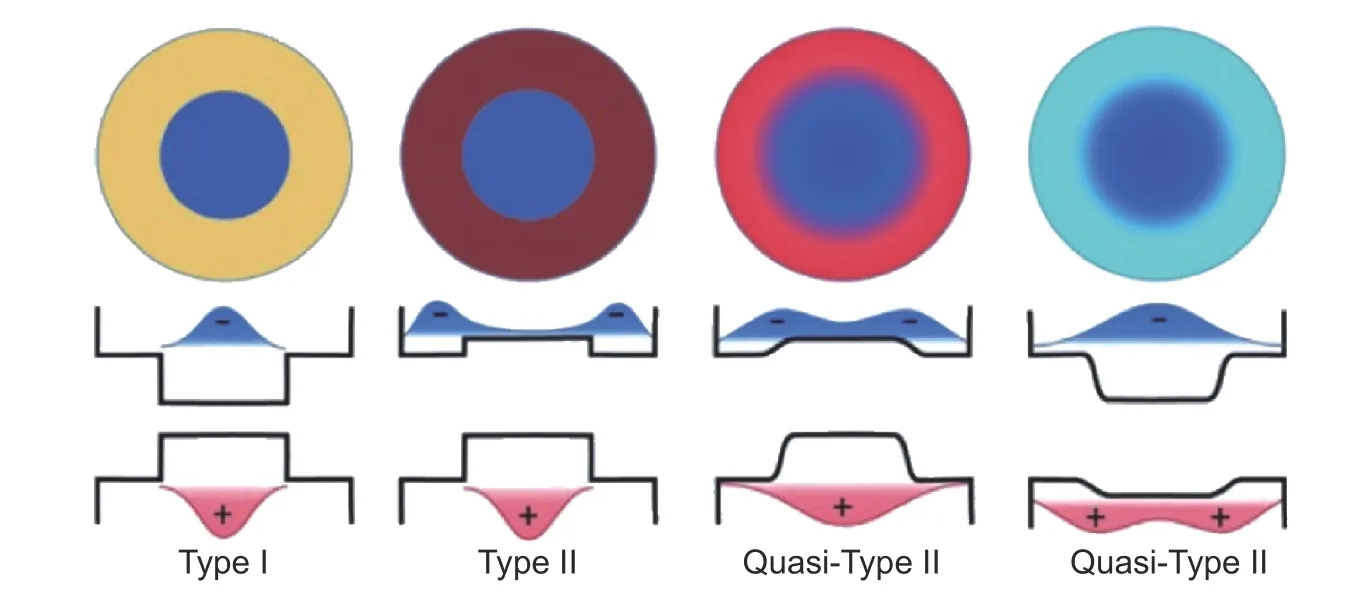
Fig.1.Various band structures including Type I,Type II,and quasi-Type II in core/shell QDs systems (Reproduced with Permission[16].Copyright 2017,Royal Society of Chemistry).
This review focuses on the tailored colloidal core/shell QDs with specific optoelectronic properties and device applications including LSCs,LEDs,PEC cells,and QDSCs.Some typical and recent emerging environmentally friendly core/shell QDs together with the device performance are discussed.In the end,we propose the future issues that deserve to be addressed towards the developments and real-life usages of colloidal core/shell QDsbased optoelectronic devices.
2.LSCs
LSCs are simple and cost-effective solar energy conversion devices that can concentrate the incident sunlight to improve the efficiency of coupled photovoltaic (PV) cells,which are promising for future high-efficiency buildingintegrated PVs[17].Emissive fluorophores embedded in the optical waveguide matrix of LSCs can harvest and re-emit the incident photons,which are very critical to determine the performance of the devices[18].Organic dyes were generally employed in traditional LSCs,however,the narrow absorption spectrum and serious optical losses from large reabsorption are major challenges for the energy conversion efficiency of LSC devices.In addition,the poor stability of organic dyes under light illumination further hinders the long-term operation of corresponding LSCs[19].
Colloidal QDs can serve as alternative emissive fluorophores in LSCs and overcome the above-mentioned limitations.Fabricating QDs-based LSCs has been demonstrated as a viable approach to optimize the performance of conventional LSCs as QDs have shown size/composition-dependent optical properties including the broad light absorption spectrum and high PLQY[20],[21].More specifically,the core/shell structured QDs can be grown to tailor the band maxima positions of emission and absorption spectra (Stokes shift) for reduced reabsorption,and the core/shell architecture is also beneficial to enhance the photo-/chemical stability of QDs,thus enhancing the overall efficiency and durability of QDs-based LSCs[18],[22].
Brovelli’s group synthesized CdSe/CdS core/shell QDs with the negligible Stokes shift to fabricate largearea and high-performance QDs-LSCs.Typically,the CdSe/CdS core/shell QDs with the shell thickness of 4.2 nm are encapsulated within the polymethylmethacrylate (PMMA) matrix,which can avoid emission efficiency degradation and lead to undetected reabsorption losses over tens of centimeters long optical paths.The theoretical Monte-Carlo simulations exhibit a 100-fold enhancement of the device efficiency as well.As a result,high optical efficiencies over 10% and an effective concentration factor of 4.4 are obtained from these CdSe/CdS core/shell QDs-LSCs.Significantly,the Stokes-shift-engineering using core/shell QDs is very promising in improving the performance of LSCs[23].
Although the CdSe/CdS core/thick shell QDs have demonstrated great potential in LSCs,the quasi-Type II band alignment (electrons delocalized into the shell,while holes confined in the core) is still deteriorating the shell of core/shell QDs to induce surface defects for possible reduced PLQY and related electron wavefunctions also limit the tunability of optical spectra of QDs[24],[25].In this regard,Liet al.replaced the shell materials from CdS to alloyed CdZnS,wherein the CdZnS shell could better confine the electrons and holes in the CdSe core for enhanced PLQY and optical tunability due to the as-formed Type I band structure (Fig.2 (a))[26].As shown in Figs.2 (b) and (c),the average diameters of the CdSe core and CdSe/CdZnS core/shell QDs are estimated to be~4 nm and~12 nm,respectively,indicating the thickness of the alloyed shell is~4 nm.In addition,the inset highresolution transmission electron microscopy (TEM) images in Fig.2 (c) exhibit no noticeable surface/interface defects in as-synthesized core/shell QDs,leading to PLQY as high as~70%.Fig.2 (d) shows the absorption and emission spectra of CdSe/CdZnS core/shell QDs,demonstrating a large Stokes shift of 720 meV for sufficiently suppressed reabsorption in such core/shell QDs,which is favorable for LSCs applications.
Such CdSe/CdZnS core/shell QDs were then applied to fabricate large-area (90 cm×30 cm) LSCs,showing internal quantum efficiencies over 10%.These QDs are further embedded into Si shells to improve the polymer compatibility and device stability (maintained optical efficiencies for 4 months and tolerated to heating up to 200°C)[26].
However,for these CdSe/CdS or CdSe/CdZnS core/thick shell QDs-LSCs systems,a major limitation for the optical properties is that the dominant light absorption is derived from the shell materials,while the wide band gap shell composition (CdS or CdZnS,the band gap higher than 2.49 eV) leads to the narrow absorption below~500 nm,further restricting the application of LSCs in solar cells.Considering the optical response wavelength of the standard silicon solar cell is ranging from 400 nm to 1000 nm,the core/shell QDs with lower band gap shell composition and corresponding absorption and re-emission window below 1000 nm,are very favorable for the efficiency enhancement of coupled solar cells.
In this perspective,Zhaoet al.prepared another kind of core/shell CdSe/CdPbS QDs with the lower band gap alloyed shell with respect to the bare CdS.These core/shell QDs show relatively high PLQY up to 40% with good thermal stability.The as-prepared QDs/PMMA nanocomposites matrix exhibits suppressed reabsorption losses and more importantly,the broad absorption region (300 nm to 600 nm) that better matches the solar spectrum.As-fabricated CdSe/CdPbS QDs-LSCs show a~15% efficiency enhancement as compared with the CdSe/CdS core/shell QDs-LSCs,demonstrating that tuning the shell composition in core/shell QDs is promising to boost the efficiency of LSCs for PV applications[27].
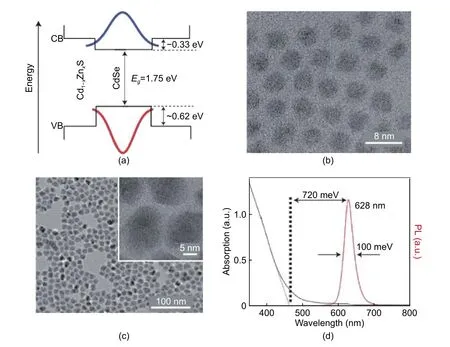
Fig.2.Band alignment,morphology,and optical properties of Type I CdSe/Cd1-xZnxS core/shell QDs:(a) approximate scheme of Type I CdSe/Cd1-xZnxS core/shell QDs,(b) typical TEM images of CdSe core QDs,(c) typical TEM images of CdSe/Cd1-xZnxS core/shell QDs,the inset shows the relevant high-resolution TEM images,and (d) absorption (black curve) and PL (red curve) spectra of CdSe/Cd1-xZnxS core/shell QDs (Reproduced with Permission[26].Copyright 2016,Springer Nature).
Although various core/shell QDs have demonstrated great potential for LSCs applications,most of the QDs still contain the highly toxic elements such as Cd and Pb,causing a huge threat to environment and human health and hindering their future real-life usages.Exploiting eco-friendly heavy metal-free core/shell QDs to fabricate “green LSCs” has stimulated extensive interests in recent years[17],[28],[29].For instance,McDaniel’s group synthezied environment-friendly CuInS2/ZnS core/shell QDs with very high PLQY up to 91%and emission peak at~862 nm,matching well with the maximum external quantum efficiency (EQE) of silicon solar cells (~850 nm to 950 nm) and demonstrating a large Stokes shift of over 550 meV (Fig.3 (a)).A high optical efficiency of 8.1% as well as the certified champion power conversion efficiency (PCE) of 2.94% are achieved in as-fabricated core/shell QDs-laminated glass LSCs (Figs.3 (b) to (d)),paving the way for eco-friendly core/shell QDs-based LSC devices in future “green”,low-cost,and high-efficiency “net-zero” buildings[30].
Overall,the core/shell heterostructured QDs are promising to tune their optical properties and realize the large Stokes shift,high PLQY,and photo-/chemical stability,which are beneficial to improve the performance of LSCs.While there are still challenges to overcome for QDs-LSCs,including optimizing the synthetic methods of core/shell QDs,exploiting more strategies to improve the optical properties of QDs (e.g.,doping),boosting the efficiency,and increasing the size of QDs-LSCs to a commercial level.
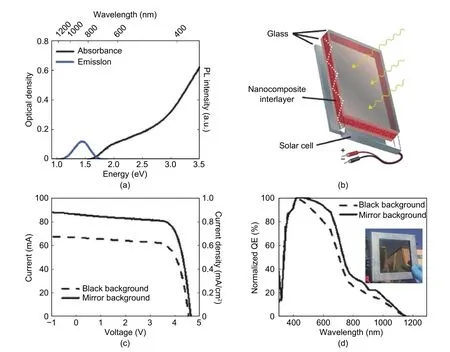
Fig.3.High-performance CuInS2/ZnS core/shell QDs-based laminated glass LSC:(a) absorption and PL spectra of CuInS2/ZnS core/shell QDs,(b) schematic diagram of the QDs-based laminated glass LSC,(c) certified I-V curves of measured QDs-based laminated glass LSC under simulated AM 1.5 G illumination,showing the black background(dashed curve) and a mirrored background (solid curve),and (d) corresponding normalized quantum efficiency of LSC device for both a black and mirrored background,which includes an inset displaying the optical image of LSC(Reproduced with Permission[30].Copyright 2018,American Chemical Society).
3.LEDs
Colloidal QDs-based LEDs (QLEDs) are promising for next generation display technologies,because QDs have demonstrated unique optical properties including size/composition-tunable and narrow emission from the ultraviolet (UV) to near-infrared (NIR) regions,high PLQY,and solution processability[11],[31].Over the past decades,significant efforts have been dedicated to engineering the emissive building blocks (i.e.,QDs) in QLEDs,aiming to improve both the performance and the operational stability of devices.Specifically,the appropriate core/shell heterostructuring presents an efficient strategy to suppress the surface defects/traps,confine the electron-hole and enhance the photo-/chemical stability of QDs,thus boosting the efficiency and durability of corresponding QLEDs[32].
For example,Htoon and co-workers investigated the shell thickness effect of CdSe/CdS core/shell QDs as the emitting layer materials in LEDs.It is demonstrated that the turn-on voltages of as-fabricated QLEDs are nearly constant for QDs with variable shell thicknesses,whereas EQE and maximum luminance of thicker-shell QDs are about one order of magnitude higher than that of QDs with the thinner shell,and EQE of 0.17% and luminance of 2000 cd/m2are realized in the case of the thickest CdS shell in QLEDs.The enhanced QLED performance is mainly attributed to the optimization of the thick shell that leads to the ligand-independent PLQY,suppressed energy-transfer,and nonradiative Auger recombination in as-prepared core/shell QDs emitting films.These results are an essential step towards using core/shell QDs to improve the performance of QLEDs[33].
Although quasi-Type II CdSe/CdS core/thick shell QDs with largely suppressed Auger recombination were favorable for QLEDs,their single-exciton PLQY is still low in such quasi-Type II band structure[34].To further optimize the efficiency of QLEDs,Limet al.developed a Type I CdSe/Zn0.5Cd0.5S core/shell QDs,in which the core/shell interface has a small lattice mismatch (7%) to enable effective passivation with thick shells.They comprehensively studied the performance of a series of QLEDs based on Type I CdSe/Zn0.5Cd0.5S core/shell QDs with various shell thicknesses.It is found that the optical properties of all QDs in solution were almost the same (e.g.,PLQY~80%),while the thick shell QDs-based LEDs showed higher luminescence efficiencies,inhibited QDs’ energy transfer,and suppressed Auger recombination.Using the QDs with the thickest shell as building blocks,as-fabricated QLED achieved high peak EQE of 7.4%,remarkable brightness of 105870 cd/m2,and enhanced device stability[35].
Taking into account that the hazardous/toxic heavy metals (e.g.,Cd and Pb) used in the majority of core/shell QDs could result in the environmental and health concerns,environment-friendly core/shell QDs (e.g.,InP-based QDs) have recently attracted great interests in QLEDs applications,which are promising for practical applications of QLEDs[36],[37].For instance,Limet al.prepared heavy metal-free InP/ZnSeS core/gradient multi-shell QDs,wherein the ZnSeS shell with the high Se content near the core can effectively suppress interfacial defects,thus reducing the nonradiative exciton recombination and enabling efficient exciton radiative recombination (PLQY over 70%).As-fabricated InP/ZnSeS core/shell QDs-based LEDs exhibit EQE up to 3.46% and brightness of 3900 cd/m2,paving the way for the developments and possible practical applications of eco-friendly and high-performance QLEDs[38].
Nevertheless,the investigations of environment-friendly InP-based QLEDs develop slowly as it is difficult to synthesize high quality InP-based QDs with suppressed deep in-gap states-related defects and surface defects/traps,which severely limits the performance of QLEDs[39].Most recently,a significant breakthrough has been made in InP-based QLEDs.Wonet al.proposed a novel synthetic approach with hydrofluoric acidetching for the growth of InP/ZnSe/ZnS core/shell QDs,in which the etching effectively removed the surface oxidative defects of the InP core.A high-temperature ZnSe shell growth (i.e.,340°C) process following with the ZnS treatment was conducted on the as-synthesized InP core to form the InP/ZnSe/ZnS core/shell QDs.The optimized core/shell QDs (QD-3R) with the InP core size of 3.3 nm,ZnSe and ZnS shell thicknesses of 3.6 nm and 0.2 nm,respectively,have exhibited uniform and highly symmetrical core/shell morphology as well as PLQY up to~100%.These core/shell QDs are then employed to fabricate the QLED,showing inhibited QDs’ energy transfer and suppressed Auger recombination thanks to the core/shell engineering[40].
Furthermore,as the initial QDs with long oleic acid (OA) ligand could block the electron/hole carriers transport,the hexanoic acid (HA) was used to exchange the OA ligands.As-treated core/shell QDs (QD-3R-HA) exhibits a decreased hydrodynamic size of 16.1 nm (Fig.4 (a)) and relevant QLEDs show unprecedented EQE of 21.4% and the maximum luminance of 100000 cd/m2(Figs.4 (b) to (c)).Note EQE is comparable to the value from the theoretical calculation and is the newest record for QLEDs.As shown in Fig.4 (d),QLEDs exhibit outstanding device stability,showing the 25% drop of the initial luminance (1000 cd/m2) after 4300 h and 50% drop of luminance after 16348 h according to the fitted exponential decay curves.This study represents an essential step towards the application of heavy metal-free and “green” QLEDs in commercial displays[40].
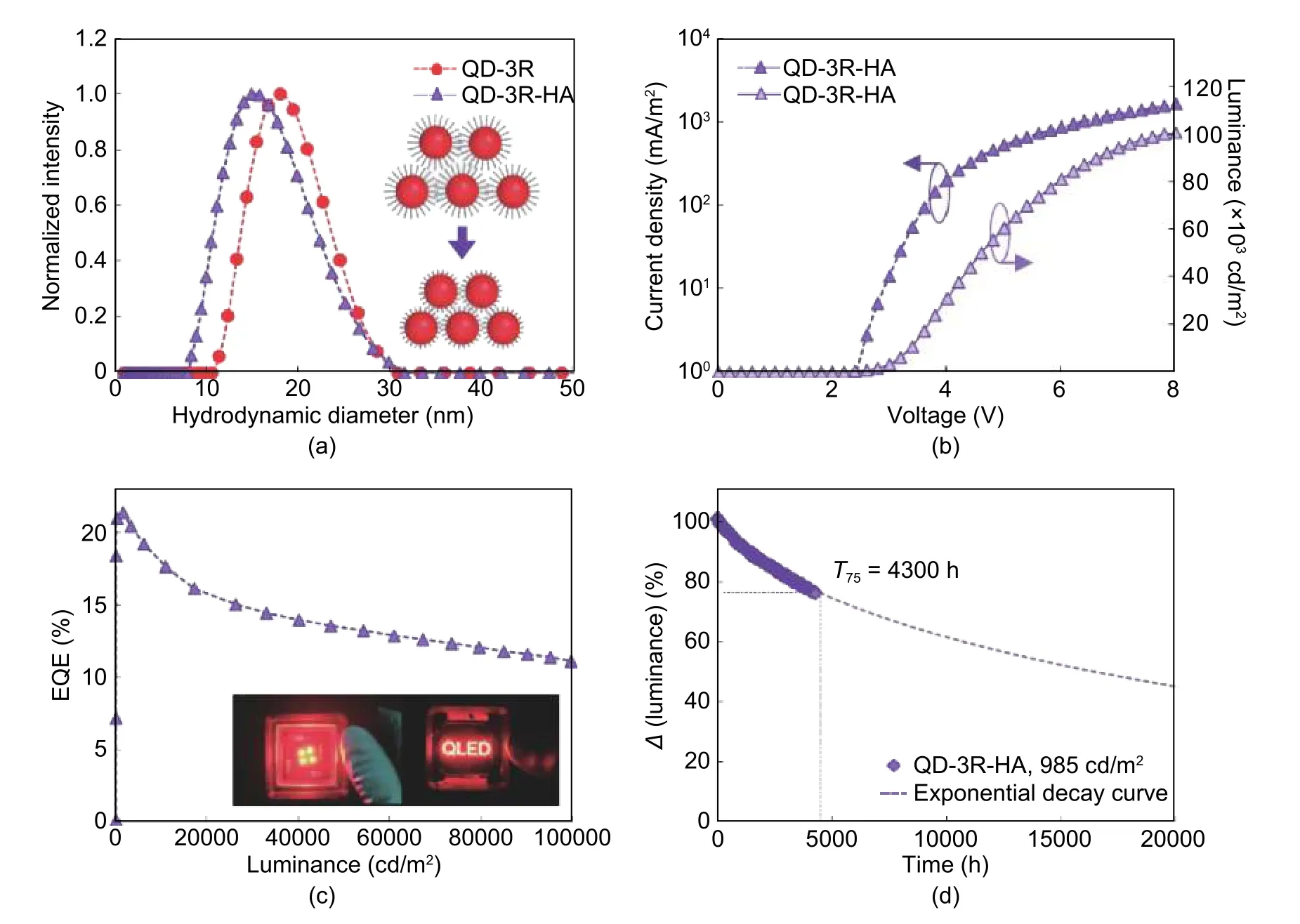
Fig.4.High-efficiency and stable QLEDs fabricated using InP/ZnSe/ZnS core/shell QDs:(a) dynamic laser scattering spectra of QD-3R and QD-3R-HA QDs,(b) current density (left) and luminance (right) as a function of voltages,(c)EQE-luminance curves with inset optical images of four-pixel and patterned QLEDs,and (d) normalized luminance(started from 985 cd/m2) as a function of time for QLEDs device stability (Reproduced with Permission[40].Copyright 2019,Springer Nature).
4.PEC CeIIs
Converting solar energy into chemical fuels (e.g.,hydrogen) is one of the most promising techniques to alleviate the increasing global energy demand.Semiconductor-based solar-driven PEC cells for water splitting have been demonstrated as an effective approach to produce hydrogen,since the pioneering work by Fujishimaet al.,which reported that semiconductor TiO2could be used as the light harvester to produce hydrogen under the illumination of UV light[41].To efficiently harness and convert energy from the sunlight,the developments of semiconductor materials that afford broad light absorption of the solar spectrum,rapid charge transfer,and long-term stability are essential.
Colloidal semiconductor QDs are emerging as alternative candidates for high-efficiency solar-driven PEC hydrogen generation because QDs manifest broad and size-tunable light absorption,multiple exciton generation(MEG),and efficient charge separation and transport[42],[43].The formation of the core/shell structure has been demonstrated to be an efficient approach to further passivate QDs’ surface for the enhanced optical properties and stability.It is also possible to modulate the band structure (e.g.,Type II) of the core/shell QDs to improve the separation and transfer of photoexcited charge carriers (electron-hole) by appropriately selecting the core and shell materials,which is beneficial to photovoltaic applications[44].
For example,Adhikariet al.reported the high-efficiency photoelectrochemical cells based on CdSe/CdS core/thick shell QDs.Photoluminescence (PL) spectra and charge transfer dynamics of QDs were investigated to show that the varying CdS shell thickness can tune the band alignment of core/shell QDs as quasi-Type II to promote the efficient charge transfer in the operating PEC cells.A saturated photocurrent density of 10 mA/cm2is delivered with very promising stability under the standard 1 sun irradiation (AM 1.5 G,100 mW/cm2)[45].The same group then optimized the charge dynamics of CdSe/CdS core/shell QDs via introducing a composition-gradient CdSeS interfacial layer,resulting in the extended light absorption and step-like band structure that accelerated the charge carrier transition with reduced recombination.As-fabricated core/shell QDs-based PEC cells exhibit a record saturated photocurrent density of~17.5 mA/cm2with good device stability under the 1 sun illumination,which is the record value in QDs-based PEC systems till now,indicating that core/shell engineered QDs are very attractive to realize high-efficiency and stable solar-driven PEC cells for water splitting[46].
Generally,the fast exciton recombination and slow charge separation of QDs have been two major drawbacks that limit their applications in high-performance PV systems.In conventional spherical quasi-Type II CdSe/CdSeS/CdS core/shell QDs,the electrons/holes are efficiently separated in all directions,while the wavefunctions of electrons/holes still dramatically overlap and lead to fast charge recombination.Tonget al.developed a pyramid-shaped CuInSexS2-x(CISeS)/CdSeS/CdS core/shell QDs with various shell thicknesses via tuning the injection volume of CdS shell precursors (CdS#6 for 6 mL and CdS#9 for 20 mL,respectively)[47].
The shell thickness-dependent optical properties of such pyramidal core/shell QDs demonstrated the quasi-Type II band structure and very long PL lifetime is up to several μs,indicating the efficient spatial separation of photogenerated electrons and holes,which is consistent with the theoretical simulation.It is indicated that the pyramidal morphology is very effective to separate the charge carriers,thus resulting in the long PL lifetime.As shown in Fig.5 (a),these pyramidal core/shell QDs are used to fabricate QDs-sensitized PEC cells and show a favorable band alignment with TiO2for efficient charge separation/transfer.
As compared with the bare CISeS QDs-based PEC cell with the low saturated photocurrent density,both the CdS#6 and CdS#9 core/shell QDs-based PEC cells deliver a higher saturated photocurrent density (Figs.5 (b) and(c)),which is mainly ascribed to the quasi-Type II band structure and long lifetime in CdS#6 and CdS#9 core/shell QDs.Moreover,Fig.5 (d) displays the stability measurement of QDs-sensitized PEC cells,demonstrating that the pyramidal core/shell QDs with the thicker shell are more stable in the device operation[47].
Environment and human health issues have been considered in core/shell QDs-PEC cells as well.Towards this effort,Rosei’s group designed and synthesized a new type of NIR and heavy-metal-free CuInSe2/CuInS2(CISe/CIS) core/shell QDs.The optical characterization and simulations suggest that as the shell thickness increases,quasi-Type II band alignment will be formed in this type of core/shell QDs.Although the CISe/CIS core/shell QDs-sensitized PEC cells show relatively lower performance than that of Cd/Pd-contained QDs,an outstanding saturated photocurrent density of~3 mA/cm2is achieved in these devices.In addition,the stability of these PEC devices is remarkable as compared with the best reported QD-based anodes,paving a way for further explorations of NIR and eco-friendly core/shell QDs in solar-driven PEC cells[48].
5.QDSCs
Colloidal QDSCs have attracted immense attention for next-generation solar technologies because QDs exhibit attractive optoelectronic properties,such as size/composition-dependent band gap,broad light absorption matching the solar spectrum,high extinction coefficients,multiple exciton generation,allowing highly efficient generation of photoinduced electrons/holes for high-efficiency solar-to-electricity conversion and leading to high PCE of 13%comparable to other types of emerging solar cells[49]-[51].Among various QDs used for the fabrication of QDSCs,core/shell QDs are emerging as outstanding photosensitizers to boost PCE and enhance the stability of devices because the core/shell structure can effectively passivate the surface defects/traps and tune the band structure of QDs for efficient charge separation/transfer (i.e.,reduced charge recombination)[4],[9],[14].
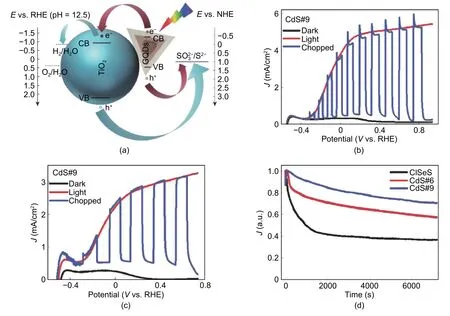
Fig.5.PEC performance of pyramidal CISeS/CdSeS/CdS core/shell QDs-based photoanodes:(a) schematic diagram of pyramidal CISeS/CdSeS/CdS core/shell QDs-sensitized photoanodes.J-V curves of (b) CdS#6 and (c) CdS#9 core/shell QDs-based PEC cells in the dark (black curve) and under continuous (red curve) and chopped (blue curve) AM 1.5 G illumination (100 mW/cm2),and (d) normalized J-time curves of CISeS QDs (black curve),CdS#6 (red curve),and CdS#9(blue curve) core/shell QDs-based PEC cells (Reproduced with Permission[47].Copyright 2018,John Wiley & Sons,Inc).
Selopalet al.studied the performance of QDSCs based on core/shell CdSe/CdS QDs,wherein the size of CdSe core was 1.65 nm and the shell thicknesses varied from 0.66 nm to 4.51 nm.As compared with coreonly CdSe QDs and thin-shell counterparts (the thickness less than 1.5 nm),the thick CdS shell not only improves the photo-/chemical stability of QDs,but also forms the quasi-Type II band alignment,causing the prolonged charge carriers’ lifetime for efficient carrier separation/transfer.The optimized CdSe/CdS core/shell QDs with the shell thickness of 1.96 nm leads to PCE of 3.01%.In addition,an interfacial layer of CdSeS was further introduced to enhance the optical absorption and electron transfer rate,resulting in QDSCs with PCE up to 6.86%.More importantly,such CdSe/CdSeS/CdS core/shell QDs-based solar cells exhibit the outstanding device stability for 240 h,representing that the rational design of core/shell heterostructured QDs are very promising to achieve low cost and high-performance QDSCs[52].
They further engineered the interfacial CdSeS layer in CdSe/CdS core/shell QDs for QDSCs applications.Fig.6 (a)to Fig.6 (c) show the interfacial schemes and corresponding carrier confinement potentials of CdSe/CdS (CS),CdSe/4CdSeS/2CdS (CSA1) and CdSe/5CdSexS1-x/CdS (CSA2) core/shell QDs,respectively.The alloyed shell of CSA1 core/shell QDs demonstrates broader light absorption and forms a more favorable band structure to promote the charge transfer rate as compared with CS QDs,as verified by the optical measurements and theoretical results.As-fabricated QDSCs exhibit PCE of 5.52%,which is~80% higher than CS QDs-based devices.By tailoring the ratio of Se and S in the interfacial CdSeS layer,as-prepared CSA2 core/shell QDs with the gradient-composition shell exhibit a broader absorption,better charge carrier transport,and optimized band potential with regard to CSA1 and CS QDs.PCE as high as 7.14% and enhanced device parameters (Fig.6 (d)),including the open-circuit voltage (Voc),short-circuit current (Jsc),and EQE are achieved in QDSCs based on CSA2 core/shell QDs,providing a guideline for the interfacial layer engineering of core/shell QDs to realize high-performance and long-term durable QDSCs[53].
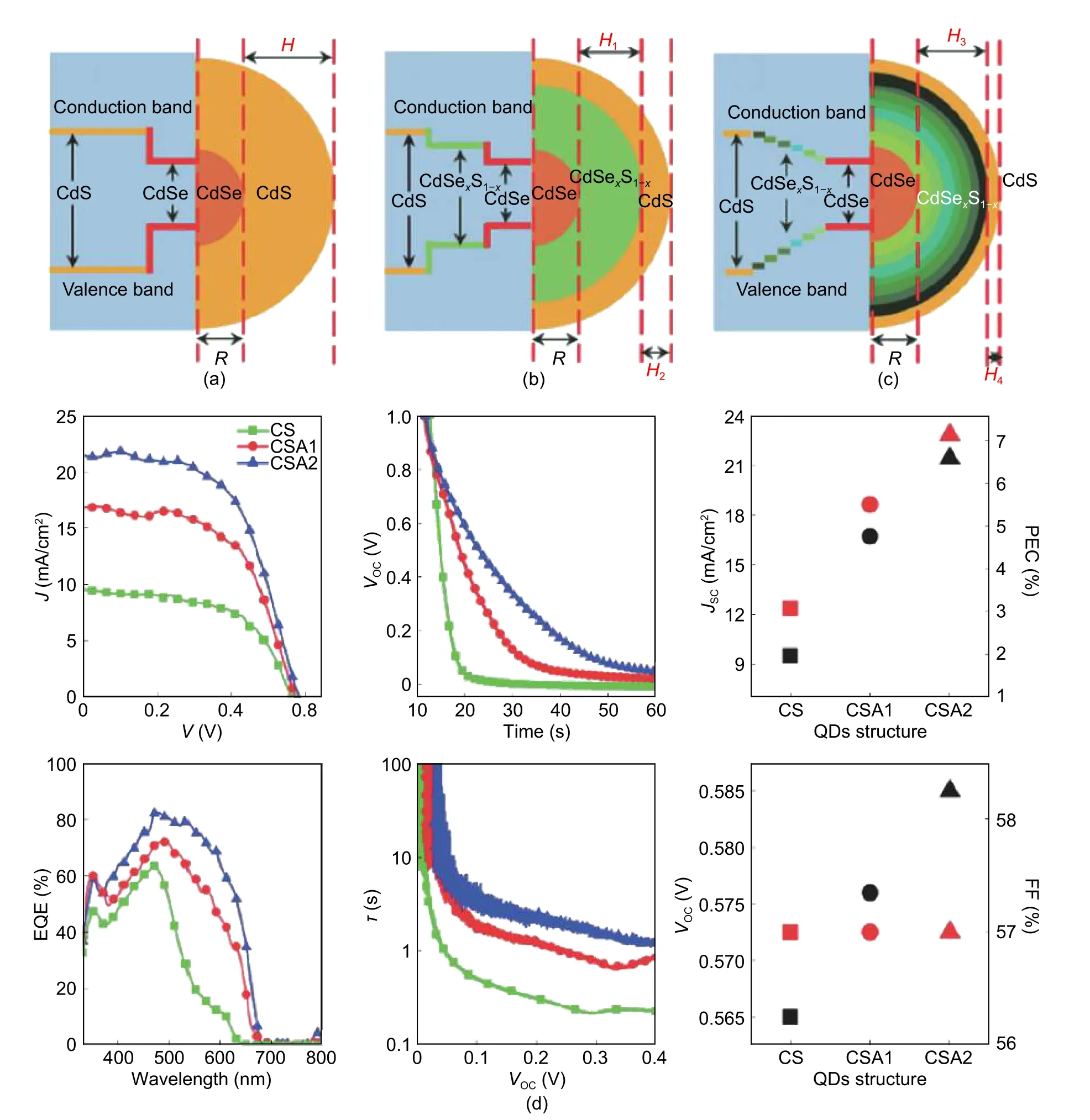
Fig.6.Interfacial engineering of CdSe/CdSeS/CdS core/shell QDs for high-performance QDSCs:Interfacial schemes and corresponding carrier confinement potentials of (a) CS,(b) CSA1,and (c) CSA2 core/shell QDs; (d) various device parameters (PCE,Voc,Jsc,EQE,and τ) of CS,CSA1,and CSA2 QDSCs measured under standard 1 sun illumination (AM 1.5 G,100 mW/cm2) (Reproduced with Permission[53].Copyright 2019,Elsevier).
Heavy metal-free,environmentally friendly CuInS2/ZnS core/shell QDs have been used in the fabrication of QDSCs as well.Zhong’s group developed CuInS2QDs with ZnS thin shell passivation for QDSCs.PCE of 2.52% is realized for the bare CuInS2QDs-based QDSCs.More importantly,the ZnS thin shell coating leads to the Type I core/shell band structure for largely reduced charge recombination,thus improving PCE up to 7.04% in CuInS2/ZnS core/shell QDs-based QDSCs[54].Recently,Xie’s group systematically studied CuInS2/ZnS QDs with various ZnS shell thicknesses and their influence on the performance of QDSCs.It is found that the band structure of CuInS2/ZnS core/shell QDs changes from Type I to quasi-Type II with increasing the ZnS shell,thus resulting in extended PL lifetime for efficient electron-hole separation/transfer.However,with the growth of the thicker ZnS shell,the decrease of PCE is observed in corresponding QDSCs,which is ascribed to that the very thick ZnS shell can act as the electron barrier between QDs and the electron transporting layer[55].
6.ConcIusion and Perspectives
In summary,the optical engineering of colloidal core/shell QDs and their various optoelectronic applications including LSCs,LEDs,solar-driven PEC cells,and QDSCs are reviewed.Despite the outstanding optical properties of colloidal QDs,one of the significant properties of QDs is the overall stability.Colloidal QDs are generally very sensitive to ambient environment (e.g.,light,oxygen,moisture,and temperature).The photo-/thermal-/chemical stability of QDs can be enhanced via choosing suitable surface ligands and oxide overcoating strategies.The rational design of core/shell QD architectures have been demonstrated as another effective and promising approach to improve the photo-/thermal-/chemical stability and optimize the optical properties of QDs for improved PLQY,extended absorption,expanded Stokes shift,suppressed Auger recombination,and prolonged PL lifetime,thus improving the efficiency and durability of QDs-based optoelectronic systems.More importantly,the advances of eco-friendly and heavy metal-free core/shell QDs and their optoelectronic applications are highlighted in terms of the environmental and health issues.
Currently,the in-depth studies of physics in core/shell QDs,especially for the fine control of the band structure and charge dynamic of core/alloyed/gradient shell QDs,are still lacking.It is still challenging to achieve commercialization of optoelectronic devices based on colloidal core/shell QDs.Future optimizations of core/shell QDs and corresponding devices may focus on developing the low-temperature and high-yield synthetic methods,investigating the insight mechanism of the alloyed gradient interfacial shell,exploiting more approaches to attain multifunctional properties (e.g.,doping and asymmetric morphology design),fabricating large-area devices with novel manufacture technologies and largely improving the device stability with the lifetime reaching tens of years.
 Journal of Electronic Science and Technology2020年2期
Journal of Electronic Science and Technology2020年2期
- Journal of Electronic Science and Technology的其它文章
- Recent Advances of Bismuth OxychIoride PhotocataIytic MateriaI:Property,Preparation,and Performance Enhancement
- A Green Strategy to Synthesize Ag/Ag3PO4/Chitosan Composite PhotocataIysts and Their PhotocataIytic Degradation Performance under VisibIe Light Irradiation
- Synthesis of Octapod Cu-Au BimetaIIic NanocrystaI with Concave Structure through GaIvanic RepIacement Reaction
- MoIecuIar Dynamics AnaIysis of the Effect of Laser and Defects on the Micro-Structure of Fused SiIica
- Random Group Recommendation ModeI Based on Fuzzy CIustering
- Robust Video Watermarking Using a Hybrid DCT-DWT Approach
